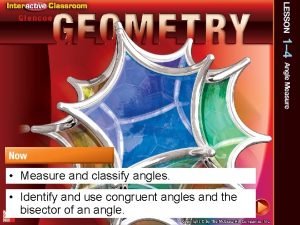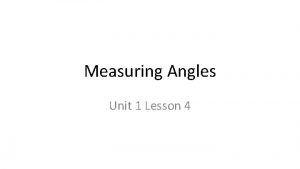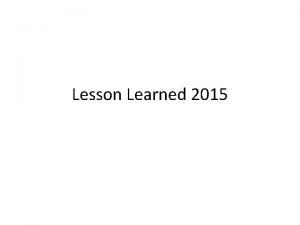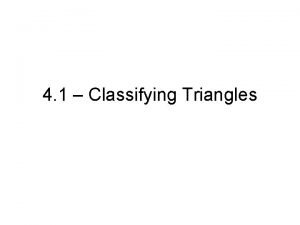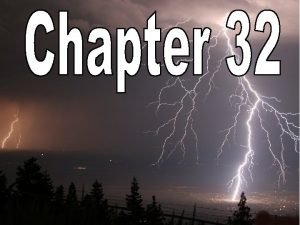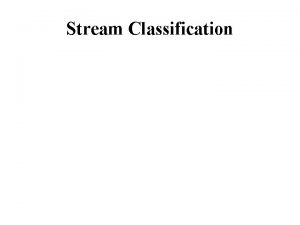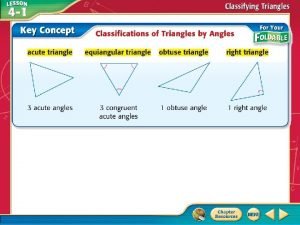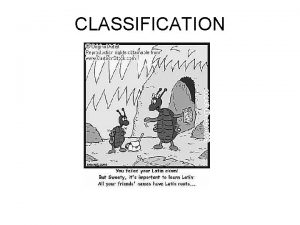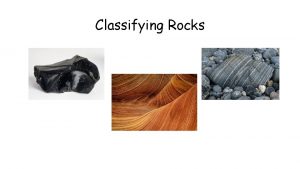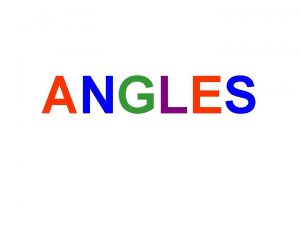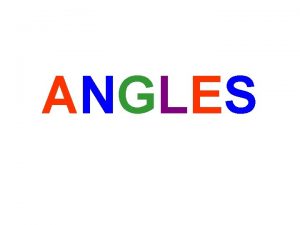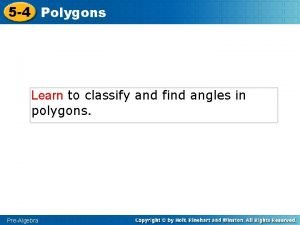Lesson 7 1 You will learn to classify






















- Slides: 22

Lesson 7 -1 You will learn to classify angles and find their measures

Parts of an Angle The corner point of an angle is called the vertex The two straight sides are called arms or sides The angle is the amount of turn between the arms. e d i s vertex angle side

Types of Angles Acute angle more than 0 o & less than 90 o Right angle Exactly 90 o Straight angle Exactly 180 o Obtuse angle more than 90 o & less than 180 o

Types of pairs of Angles 1 Complementary angles Two angles whose measures add to 90 o 55 o 60 o 35 o complementary 2 complementary Supplementary angles Two angles whose measures add to 180 o 120 o 60 o Supplementary or linear pair 105 o 75 o Supplementary

3 Adjacent angles Two angles that have a common side and a common vertex and do not overlap (angle inside the other). Non–Adjacent They do not share the same vertex Non-Adjacent They overlap

Alternative way to understand the meaning of adjacent angles do not overlap Adjacent Non-Adjacent They overlap

4 congruent angles that have the same measure A B 5 D 60 o C 60 o E F Vertical angles Two opposite angles that formed by two intersecting lines c a b d Vertical angles are congruent

Let’s P RAC T IC E

Q 1 Use the diagram to name two acute angles S T 90 o 43 o P 47 o Q and R

Q 2 Use the diagram to name two Obtuse angles S T 90 o 43 o P 47 o Q and R

Q 3 Use the diagram to name a pair of complementary angles S T 90 o 43 o P 47 o Q and R

Q 4 Vertical angles Angles a and b are called ________ angles

Q 5 Use the diagram to name a pair of Supplementary angles S T 90 o 43 o P 47 o Q and OR and R

Q 6 If find 1 Justify your answer 3 4 2 Reason: Vertical angles are congruent

Q 7 If find 1 Justify each step 3 4 2 Linear pair or straight angle substitution subtraction simplification

Q 8 A traffic engineer designed a section of roadway where three streets intersect. Based on the diagram, what is the measure of ? A F Complementary angles Subtraction Simplification B 26 o C D E

Q 9 Which angle is adjacent to ∠ DGC? a) ∠ FGA b) ∠ DGE c) ∠ EGF d) ∠ AGB

Q 10 find the measure of angle b. Complementary angles Subtraction Simplification

Q 11 find x. if Given A U Simplification Subtraction L Y Simplification Division

Q 12 find x, y and z

Q 13 false true

Lesson 5 -5 Home Work page 332, 333 (1 – 25) all
 Kinetic learning
Kinetic learning The more you study the more you learn
The more you study the more you learn Man lernt solange man lebt
Man lernt solange man lebt What is a herbivore
What is a herbivore A parallelogram is a square always, sometimes, never
A parallelogram is a square always, sometimes, never Lesson 4 classify angles
Lesson 4 classify angles Straight angle
Straight angle Lesson 4 classify angles
Lesson 4 classify angles Lesson 3 classify triangles
Lesson 3 classify triangles Learn english with jennifer lesson 3
Learn english with jennifer lesson 3 Lesson from ant
Lesson from ant Contoh lesson learned
Contoh lesson learned How do you classify uniform and non-uniform mixtures?
How do you classify uniform and non-uniform mixtures? How do you classify uniform and non-uniform mixtures?
How do you classify uniform and non-uniform mixtures? How to classify polynomial by degree
How to classify polynomial by degree Hinge tools classification
Hinge tools classification Classifying triangles by angles
Classifying triangles by angles What is parallax method
What is parallax method 3 ways to classify vegetables
3 ways to classify vegetables Classification of a motherboard
Classification of a motherboard Much to learn you still have
Much to learn you still have My reason for joining extension work activities. *
My reason for joining extension work activities. * How to obey your teachers
How to obey your teachers





